The compact SUV segment has seen significant growth, with offerings that blend style, practicality, and advanced technology. Two of the most prominent models in this category are the Nissan Qashqai and the VW T-Roc. Both vehicles provide a compelling mix of performance, comfort, and user-friendly features, but how do they stack up against each other? Let’s take a closer look at these two SUVs.
Nissan Qashqai vs VW T-Roc – Which model is better for everyday use?
Two cars, one duel: Nissan Qashqai meets VW T-Roc.
Which one wins in performance, efficiency and value for money? Find out now!
Technical Specifications
When comparing the technical specifications of the Nissan Qashqai and VW T-Roc, both vehicles stand out with their respective engines and drivetrain options. The Qashqai offers a range of engine types, including petrol MHEV and full hybrid options. It has power outputs ranging from 140 to 190 HP, accompanied by an efficient CO2 emission range of 116 to 154 g/km. The Qashqai's acceleration figures are competitive, with a 0-100 km/h time that can go as low as 7.9 seconds, emphasizing its sporty potential.
On the other hand, the VW T-Roc also presents a diverse selection of engines, including petrol and diesel, with power outputs between 115 and 300 HP. This means that the T-Roc can cater to a broader audience, particularly with the high-performance version. The acceleration performance is commendable, with some variants achieving 0-100 km/h in just 4.9 seconds, making the T-Roc a potential frontrunner for those seeking speed.
Drivetrain and Transmission Options
Both SUVs provide front-wheel drive and all-wheel drive configurations. The Qashqai features various transmission options, including manual gearboxes and continuously variable transmission (CVT) systems, allowing drivers to choose based on their preferences for driving dynamics and fuel efficiency. Its manual transmission is noted for its smooth shifts, while the automatic options deliver seamless power delivery.
The T-Roc provides similar transmission options but adds an automated dual-clutch system, which enhances the driving experience through rapid gear changes. This feature is particularly appealing to those who enjoy the engagement of sportier driving without sacrificing comfort.
Interior Space and Comfort
Inside, the Nissan Qashqai boasts a slightly larger trunk capacity, offering 504 liters compared to the T-Roc's maximum of 445 liters. This makes the Qashqai a more practical choice for families or those needing extra cargo space. Both vehicles are equipped to seat up to five passengers comfortably, but the rear seats in the Qashqai might offer slightly more legroom, enhancing passenger comfort on longer journeys.
In terms of materials and user interface, the T-Roc showcases VW's renowned build quality, with a modern aesthetic and intuitive infotainment technology. The digital cockpit feature is a highlight, providing customizable displays that keep all necessary information in the driver’s line of sight.
Fuel Efficiency
Fuel efficiency is crucial for any SUV buyer, and here both models perform commendably. The Qashqai achieves consumption figures as low as 5.1 L/100 km in its hybrid configurations, while the T-Roc offers competitive figures, with the most efficient versions clocking in around 4.7 L/100 km. Depending on your driving style and fuel preferences, both SUVs can provide economic benefits, with the T-Roc edging ahead in some diesel variants.
Conclusion: Which SUV Reigns Supreme?
Ultimately, the choice between the Nissan Qashqai and VW T-Roc will depend on personal preferences and requirements. The Qashqai excels in practicality, comfort, and hybrid efficiency, making it ideal for those seeking a reliable family SUV. In contrast, the T-Roc captures attention with its sporty performance, advanced tech, and design flair, appealing to drivers who prioritize style and driving enjoyment.
Both SUVs represent the best of their respective brands and will meet various consumer needs. Therefore, test-driving both models will be advised to truly appreciate what they offer and make an informed decision based on individual expectations.
Here’s where it gets real: The technical differences in detail
Costs and Efficiency:
When it comes to price and running costs, the biggest differences usually appear. This is often where you see which car fits your budget better in the long run.
VW T-Roc has a somewhat advantage in terms of price – it starts at 26400 £, while the Nissan Qashqai costs 29400 £. That’s a price difference of around 2953 £.
Fuel consumption also shows a difference: Nissan Qashqai manages with 5.10 L and is therefore slight more efficient than the VW T-Roc with 5.50 L. The difference is about 0.40 L per 100 km.
Engine and Performance:
Power, torque and acceleration say a lot about how a car feels on the road. This is where you see which model delivers more driving dynamics.
When it comes to engine power, the Nissan Qashqai has a noticeable edge – offering 190 HP compared to 150 HP. That’s roughly 40 HP more horsepower.
In acceleration from 0 to 100 km/h, the Nissan Qashqai is a bit quicker – completing the sprint in 7.90 s, while the VW T-Roc takes 8.90 s. That’s about 1 s faster.
In terms of top speed, the VW T-Roc performs barely noticeable better – reaching 212 km/h, while the Nissan Qashqai tops out at 206 km/h. The difference is around 6 km/h.
There’s also a difference in torque: Nissan Qashqai pulls evident stronger with 330 Nm compared to 250 Nm. That’s about 80 Nm difference.
Space and Everyday Use:
Cabin size, boot volume and payload all play a role in everyday practicality. Here, comfort and flexibility make the difference.
Both vehicles offer seating for 5 people.
In curb weight, Nissan Qashqai is hardly perceptible lighter – 1420 kg compared to 1465 kg. The difference is around 45 kg.
In terms of boot space, the Nissan Qashqai offers slight more room – 504 L compared to 475 L. That’s a difference of about 29 L.
In maximum load capacity, the Nissan Qashqai performs minimal better – up to 1447 L, which is about 97 L more than the VW T-Roc.
When it comes to payload, Nissan Qashqai barely noticeable takes the win – 520 kg compared to 515 kg. That’s a difference of about 5 kg.
Who comes out on top?
Overall, the Nissan Qashqai shows itself to be wins the duel decisively and secures the title of DriveDuel Champion.
It convinces with the more balanced overall package and proves to be the more versatile choice for everyday use.
 @ Nissan Motor Corporation
@ Nissan Motor Corporation
Nissan Qashqai
Nissan Qashqai
The Nissan Qashqai blends practical, family-friendly packaging with SUV styling that refuses to shout, making it a sensible and dependable choice for everyday life. It’s comfortable to live with, economical on the road, and neatly equipped enough to feel modern without ever feeling precious — perfect if you want crossover versatility without the drama.
details @ Nissan Motor Corporation
@ Nissan Motor Corporation
 @ Nissan Motor Corporation
@ Nissan Motor Corporation
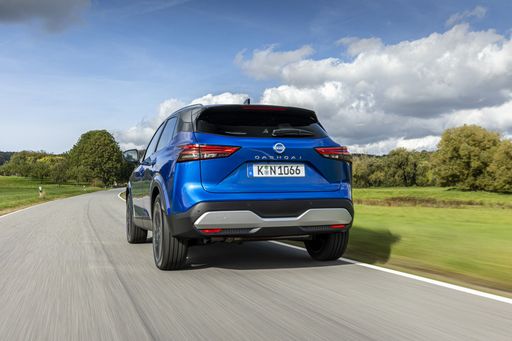 @ Nissan Motor Corporation
@ Nissan Motor Corporation
 @ Nissan Motor Corporation
@ Nissan Motor Corporation
 @ Nissan Motor Corporation
@ Nissan Motor Corporation
VW T-Roc
The VW T-Roc mixes cheeky, coupe-like styling with the everyday sense and space of an SUV, so it looks fun without sacrificing family sense. It’s a likeable all-rounder with tidy road manners and plenty of personality, ideal if you want a car that’s practical enough for chores but entertaining enough to enjoy.
details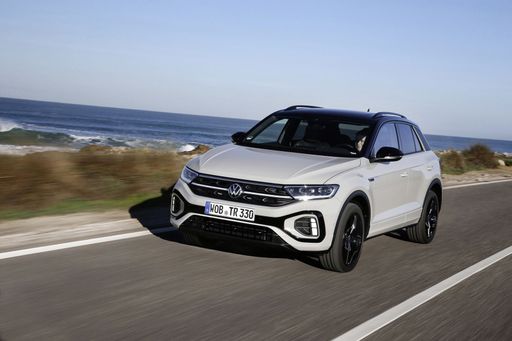 @ Volkswagen AG / VW Media
@ Volkswagen AG / VW Media
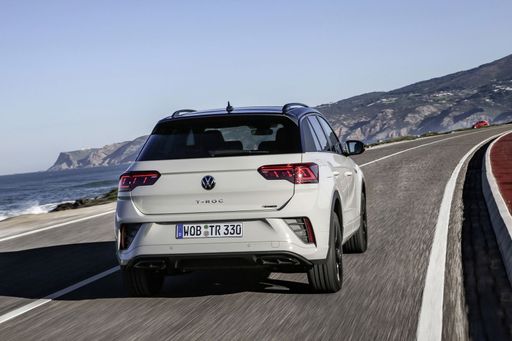 @ Volkswagen AG / VW Media
@ Volkswagen AG / VW Media
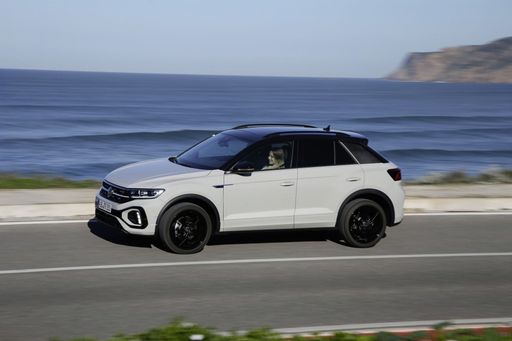 @ Volkswagen AG / VW Media
@ Volkswagen AG / VW Media
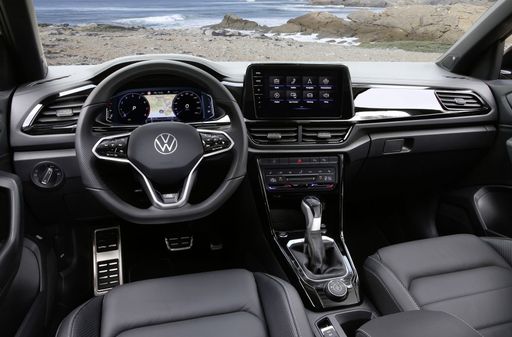 @ Volkswagen AG / VW Media
@ Volkswagen AG / VW Media
 @ Nissan Motor Corporation
@ Nissan Motor Corporation
|
 @ Volkswagen AG / VW Media
@ Volkswagen AG / VW Media
|
|
|
|
Costs and Consumption |
|
|---|---|
|
Price
29400 - 42500 £
|
Price
26400 - 38000 £
|
|
Consumption L/100km
5.1 - 6.8 L
|
Consumption L/100km
5.5 - 6.3 L
|
|
Consumption kWh/100km
-
|
Consumption kWh/100km
-
|
|
Electric Range
-
|
Electric Range
-
|
|
Battery Capacity
-
|
Battery Capacity
-
|
|
co2
116 - 154 g/km
|
co2
126 - 143 g/km
|
|
Fuel tank capacity
55 L
|
Fuel tank capacity
50 L
|
Dimensions and Body |
|
|---|---|
|
Body Type
SUV
|
Body Type
SUV
|
|
Seats
5
|
Seats
4 - 5
|
|
Doors
5
|
Doors
2 - 5
|
|
Curb weight
1420 - 1665 kg
|
Curb weight
1465 - 1539 kg
|
|
Trunk capacity
479 - 504 L
|
Trunk capacity
284 - 475 L
|
|
Length
4425 mm
|
Length
4271 - 4373 mm
|
|
Width
1835 mm
|
Width
1811 - 1828 mm
|
|
Height
1625 mm
|
Height
1527 - 1573 mm
|
|
Max trunk capacity
1422 - 1447 L
|
Max trunk capacity
1350 L
|
|
Payload
466 - 520 kg
|
Payload
368 - 515 kg
|
Engine and Performance |
|
|---|---|
|
Engine Type
Petrol MHEV, Full Hybrid
|
Engine Type
Petrol, Petrol MHEV
|
|
Transmission
Manuel, Automatic
|
Transmission
Manuel, Automatic
|
|
Transmission Detail
Manual Gearbox, CVT, Reduction Gearbox
|
Transmission Detail
Manual Gearbox, Dual-Clutch Automatic
|
|
Drive Type
Front-Wheel Drive, All-Wheel Drive
|
Drive Type
Front-Wheel Drive
|
|
Power HP
140 - 190 HP
|
Power HP
115 - 150 HP
|
|
Acceleration 0-100km/h
7.9 - 10.2 s
|
Acceleration 0-100km/h
8.9 - 12.3 s
|
|
Max Speed
170 - 206 km/h
|
Max Speed
187 - 212 km/h
|
|
Torque
240 - 330 Nm
|
Torque
200 - 250 Nm
|
|
Number of Cylinders
3 - 4
|
Number of Cylinders
3 - 4
|
|
Power kW
103 - 140 kW
|
Power kW
85 - 110 kW
|
|
Engine capacity
1332 - 1497 cm3
|
Engine capacity
999 - 1498 cm3
|
General |
|
|---|---|
|
Model Year
2024
|
Model Year
2024 - 2025
|
|
CO2 Efficiency Class
E, D
|
CO2 Efficiency Class
E, D
|
|
Brand
Nissan
|
Brand
VW
|
Is the Nissan Qashqai offered with different drivetrains?
Available configurations include Front-Wheel Drive or All-Wheel Drive.
The prices and data displayed are estimates based on German list prices and may vary by country. This information is not legally binding.
